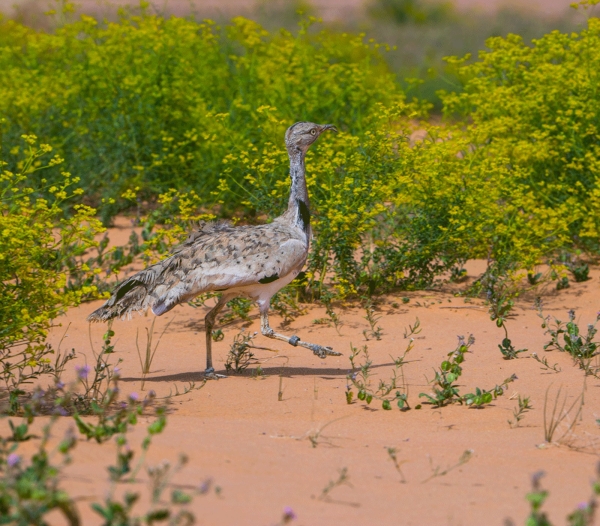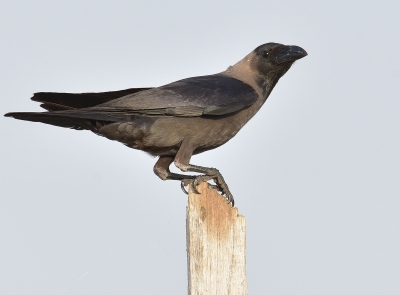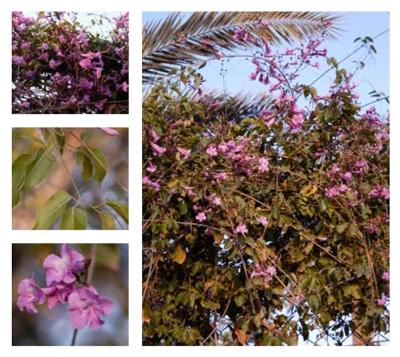
The Asian Houbara (scientific name: Chlamydotis macqueenii) is a bird native to the Kingdom of Saudi Arabia. During winter, it migrates south and southwest within the Kingdom. Classified as a rare bird, it inhabits shallow sandy valleys and the depressions of Harrat al-Harrah, one of the natural areas within King Salman Bin Abdulaziz Royal Reserve. This reserve is located east of Wadi as-Sirhan in al-Jawf Province, north of the Kingdom, and spans an area of 13,775 km.
Life of the Asian Houbara
The diet of the Asian Houbara consists of plant parts and various invertebrates, such as grasshoppers, locusts, beetles, and possibly snakes and lizards found on the ground. It does not drink water. Observations of some individuals have shown that the bird may travel up to sixty km in search of food.
This bird is active during twilight and partially during the day and night. It sometimes forages on moonlit nights and lives a solitary life. Its size ranges between fifty-five and seventy-five cm, with its weight varying by gender. Males weigh between 1,800 and 3,200 g, while females weigh between 1,200 and 1,700 g.
Reproduction of the Asian Houbara
Male Asian Houbaras gather in a communal display area at traditional lekking sites, where each male defends a small territory. The female selects a male for mating and then leaves to prepare a nest in a nearby area, which does not necessarily fall within the male's territory. A single clutch may include offspring from multiple males.
The female Asian Houbara incubates two or three eggs in a nest located in an unlined shallow depression on open ground, usually near a short tree. The incubation period lasts twenty-three to twenty-four days. The female cares for the chicks until they leave the nest shortly after hatching and become capable of flight at the age of thirty-five days. The clutch is typically singular. The bird breeds in the Kingdom with approximately thirty pairs annually.
Protecting the Asian Houbara from extinction in Saudi Arabia
The Asian Houbara population in the Kingdom has declined due to overhunting. To protect it from extinction and as part of the Kingdom’s efforts to preserve the environment, wildlife, and biodiversity, the Houbara Breeding and Reintroduction Project was launched in 1986. The National Wildlife Research Center in Taif successfully reintroduced the Asian Houbara into Mahazat as-Sayd Protected Area and Saja and Umm ar-Rimth Protected Area. The former National Commission for Wildlife Conservation and Development released thirty Houbara into Saja and Umm ar-Rimth Protected Area in 2005.
The Prince Saud al-Faisal Wildlife Research Center works on breeding and reintroducing the Houbara in collaboration with the National Center for Wildlife. The center established a breeding program for the Houbara Bustard and successfully hatched the first Houbara egg in 1989 after improving artificial insemination and incubation techniques. The center managed to produce sufficient numbers, leading to the first release into the wild in 1991 within Imam Saud Bin Abdulaziz Royal Reserve (formerly Mahazat as-Sayd), located northwest of Taif Governorate. The reserve features moderate vegetation cover, which helps preserve the genetic heritage of certain bird species. The number of Houbara released into the reserve between 1991 and 1998 reached 330 birds. Natural breeding of the birds in the reserve began in 1995, and the first Houbara nests were recorded in the center of the Kingdom after an absence of over forty years. The center increased production through genetic selection to over eight hundred birds in 2022.
Releasing the Houbara Bustard in royal reserves
A number of Houbara Bustards were released in Imam Saud Bin Abdulaziz Royal Reserve, creating a natural extension for the spread of Houbaras between the reserve and their various breeding habitats.
In 2022, the Imam Abdulaziz Bin Mohammed Royal Reserve Development Authority, located near Ghailanah Center in Rumah Governorate, Riyadh Province, released a group of Houbara Bustards within the reserve, as well as in the King Khalid Royal Reserve. This was done in collaboration with the National Center for Wildlife as part of efforts to reintroduce endangered wildlife species to their natural habitats, increase their numbers, promote their growth, and ensure their preservation.
King Salman Bin Abdulaziz Royal Reserve serves as a natural sanctuary for the Houbara Bustard. The reserve actively implements conservation programs, continuous monitoring, and tracking efforts to protect the bird from threats. Experts and field teams from the authority observe the natural breeding moments of the Houbara during its annual migration through the Kingdom.
The Imam Turki Bin Abdullah Royal Reserve Development Authority established a specialized center for breeding Houbaras within the reserve. The center aims to increase the population of Houbaras, reintroduce them into their natural habitats, and utilize surplus production for sustainable hunting. In 2024, the authority established a Houbara breeding center within the reserve as part of a plan to reintroduce the Houbaras to its original habitat within the reserve. The center includes twenty-two diverse facilities, comprising dedicated Houbara breeding units, production enclosures, clinics, laboratories, and logistical facilities. The center simulates natural living conditions suitable for the Houbara Bustard. It is fully enclosed and specializes in studies, research, and the reintroduction of Houbara Bustards into their suitable natural habitats. The center spans an area of four km², with a production capacity of up to 25,000 birds.
Private sector and Houbara breeding
In 2023, the National Center for Wildlife issued the first official license for Houbara production in the Kingdom to a specialized center in Qassim Province. The center aims to accelerate meeting the Kingdom's demand for Houbara by providing scientifically and systematically developed solutions to increase wildlife populations, contributing to enhanced environmental balance and improved biodiversity within the Kingdom. The center aims to produce 15,000 Houbara Bustards by 2026. The project spans an area exceeding five hundred thousand m² and focuses on preparing Houbara Bustards even after their release to achieve self-sufficiency in Houbara production within the Kingdom.
Related quizzes
Related articles


